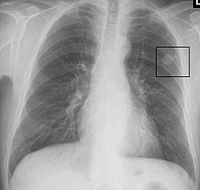
Photo from wikipedia
BackgroundSolitary pulmonary nodules (SPN) are frequently detected in cancer patients. These lesions are often considered as pulmonary metastases and increasingly treated by non-surgical techniques without histological confirmation. The aim of… Click to show full abstract
BackgroundSolitary pulmonary nodules (SPN) are frequently detected in cancer patients. These lesions are often considered as pulmonary metastases and increasingly treated by non-surgical techniques without histological confirmation. The aim of this study is to determine the histological nature of SPN resected by thoracoscopy and to identify risk factors of malignancy.MethodsSingle-institution retrospective analysis of all consecutive patients with previously known malignancies who underwent thoracoscopic resection of SPN with unknown diagnosis between 2001 and 2014.ResultsOne hundred and forty cancer patients underwent thoracoscopic resection of a SPN. The resected SPN was benign in 34 patients (24.3%) and malignant in 106 patients. The latter were metastasis in 70 patients (50%) and a primary lung cancer in 36 patients (25.7%). Upon univariate analysis, malignancy was significantly associated with age >60 years, disease-free interval ≥24 months, SPN size >8 mm, upper lobe localization and SUVmax > 2.5 on PET-CT. Upon multivariate analysis, upper lobe localization and SUVmax > 2.5 were associated with malignancy. Smoking was significantly associated with SPN containing primary lung cancer.ConclusionIn this series, only 50% of SPN in patients with known malignant disease were pulmonary metastases and 25% had a newly diagnosed NSCLC. Smoking was associated with primary lung cancer but no other predictor was found to allow the distinction between pulmonary metastasis and lung cancer. These results endorse the need of histological confirmation of SPN in patients with previous malignancies to avoid diagnostic uncertainty and suboptimal treatments.
Journal Title: Surgical Endoscopy
Year Published: 2017
Link to full text (if available)
Share on Social Media: Sign Up to like & get
recommendations!